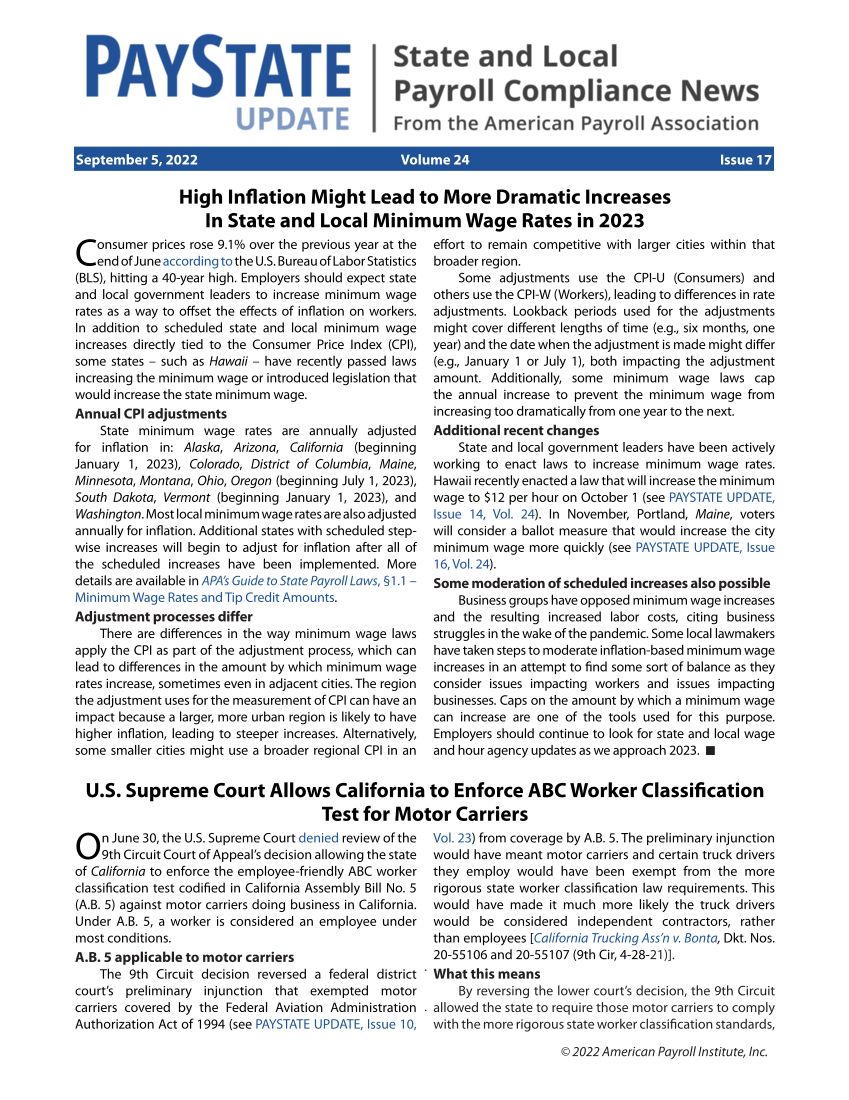© 2022 American Payroll Institute, Inc. High Inflation Might Lead to More Dramatic Increases In State and Local Minimum Wage Rates in 2023 Consumer prices rose 9.1% over the previous year at the end of June according to the U.S. Bureau of Labor Statistics (BLS), hitting a 40-year high. Employers should expect state and local government leaders to increase minimum wage rates as a way to offset the effects of inflation on workers. In addition to scheduled state and local minimum wage increases directly tied to the Consumer Price Index (CPI), some states – such as Hawaii – have recently passed laws increasing the minimum wage or introduced legislation that would increase the state minimum wage. Annual CPI adjustments State minimum wage rates are annually adjusted for inflation in: Alaska, Arizona, California (beginning January 1, 2023), Colorado, District of Columbia, Maine, Minnesota, Montana, Ohio, Oregon (beginning July 1, 2023), South Dakota, Vermont (beginning January 1, 2023), and Washington. Most local minimum wage rates are also adjusted annually for inflation. Additional states with scheduled step- wise increases will begin to adjust for inflation after all of the scheduled increases have been implemented. More details are available in APA’s Guide to State Payroll Laws, §1.1 – Minimum Wage Rates and Tip Credit Amounts. Adjustment processes differ There are differences in the way minimum wage laws apply the CPI as part of the adjustment process, which can lead to differences in the amount by which minimum wage rates increase, sometimes even in adjacent cities. The region the adjustment uses for the measurement of CPI can have an impact because a larger, more urban region is likely to have higher inflation, leading to steeper increases. Alternatively, some smaller cities might use a broader regional CPI in an effort to remain competitive with larger cities within that broader region. Some adjustments use the CPI-U (Consumers) and others use the CPI-W (Workers), leading to differences in rate adjustments. Lookback periods used for the adjustments might cover different lengths of time (e.g., six months, one year) and the date when the adjustment is made might differ (e.g., January 1 or July 1), both impacting the adjustment amount. Additionally, some minimum wage laws cap the annual increase to prevent the minimum wage from increasing too dramatically from one year to the next. Additional recent changes State and local government leaders have been actively working to enact laws to increase minimum wage rates. Hawaii recently enacted a law that will increase the minimum wage to $12 per hour on October 1 (see PAYSTATE UPDATE, Issue 14, Vol. 24). In November, Portland, Maine, voters will consider a ballot measure that would increase the city minimum wage more quickly (see PAYSTATE UPDATE, Issue 16, Vol. 24). Some moderation of scheduled increases also possible Business groups have opposed minimum wage increases and the resulting increased labor costs, citing business struggles in the wake of the pandemic. Some local lawmakers have taken steps to moderate inflation-based minimum wage increases in an attempt to find some sort of balance as they consider issues impacting workers and issues impacting businesses. Caps on the amount by which a minimum wage can increase are one of the tools used for this purpose. Employers should continue to look for state and local wage and hour agency updates as we approach 2023. U.S. Supreme Court Allows California to Enforce ABC Worker Classification Test for Motor Carriers On June 30, the U.S. Supreme Court denied review of the 9th Circuit Court of Appeal’s decision allowing the state of California to enforce the employee-friendly ABC worker classification test codified in California Assembly Bill No. 5 (A.B. 5) against motor carriers doing business in California. Under A.B. 5, a worker is considered an employee under most conditions. A.B. 5 applicable to motor carriers The 9th Circuit decision reversed a federal district court’s preliminary injunction that exempted motor carriers covered by the Federal Aviation Administration Authorization Act of 1994 (see PAYSTATE UPDATE, Issue 10, Vol. 23) from coverage by A.B. 5. The preliminary injunction would have meant motor carriers and certain truck drivers they employ would have been exempt from the more rigorous state worker classification law requirements. This would have made it much more likely the truck drivers would be considered independent contractors, rather than employees [California Trucking Ass’n v. Bonta, Dkt. Nos. 20-55106 and 20-55107 (9th Cir, 4-28-21)]. What this means By reversing the lower court’s decision, the 9th Circuit allowed the state to require those motor carriers to comply with the more rigorous state worker classification standards, September 5, 2022 Volume 24 Issue 17
Printed for: PayrollOrg Bookshelf © 2024 American Payroll Institute, Inc. All Rights reserved. From: PayrollOrg Digital Publications (bookshelf.payroll.org)






